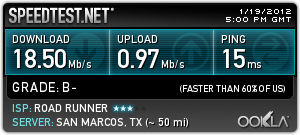A less than stellar AT&T DSL experience leads me to stick with the devil I know.
Time Warner unceremoniously decided to raise my Internet service cost by $5.00/month, so it was time to check out the competition. AT&T DSL is available for a $15/month year-long rate. That’s a significant savings, but Time Warner’s Internet service has been almost flawless, and I’ve been mostly happy with it since signing up as one of the charter customers in Austin — back in the day, they actually made my roommate go to a training class so that we could get it hooked up at the house.
The only real hiccup with Time Warner came when they without notice simply cut me off. I was traveling quite a bit at the time, and came home one weekend to find that my service was dead. After some troubleshooting, I determined that it had to be the cable service itself, so I called Time Warner, and they informed me that I was, they claimed, in the top 2% of bandwidth users, so they cut off my service. Keep in mind that there is no published bandwidth limit with TWC, but as an early adopter of Netflix streaming, it’s possible my usage was uncommonly high. Still, I paid premium rates, and they agreed to give me 6Mbps — no advertised limit anywhere. We had a spirited discussion, and they agreed to turn it back on. Not a problem since.
Over the years, I’ve called more than once to ask them to lower the rate to keep competitive, and they have, but this time, I called up AT&T to try out DSL — without canceling the Time Warner service just yet.
The AT&T customer experience was sad. The first DSL order placed on the web was cancelled — that’s another story entirely. The second DSL order went through, but when the technician arrived days later, he could not complete the order because the address was off by ONE DIGIT. The follow up process entailed calling back again and setting up a second visit, but the technician assured me the next technician wouldn’t have to go into the house and nobody would have to be home, because the wiring was tested and ready to go.
The second technician visited while I was away, and left a note at the door that the install was complete. When I connected the DSL modem, the red light came on indicating no service. I called the second technician, who was nice enough to leave a card, and explained that the install was definitely not complete because the service was not working. We had a bizarre discussion in which he asked me if I had Time Warner, and he asked me to unplug their phone connections (there are none) — and he basically gave me a list of the top few reasons DSL might not be working, and what I could do to fix those problems. He was trying to be helpful, but I used to be a network technician, and most of what he was telling me was, at least in my case, irrelevant, inapplicable or useless. After I used fancy technical terms like “RJ11,” he suggested that I just go back and basically fiddle with the “blue wires” outside my house. He explained that since it was getting late, I could also call the business office, set up third order, and have another tech visit the house days later.
While the literal conversation was useless, the figurative message inferred was that he’d connected it on the back end, and that “this is not rocket science.” So, I went outside, and without the benefit of proper tools, used a process of elimination to correctly identify the DSL wires and wired it up in less than an hour. It was the orange wires, not the blue ones, by the way. This was a little more than I expected when I signed up for a self-install, but the DSL connection works great.
So here are the initial results. As expected, the DSL is slower than cable, but Netflix HD video streaming still works, and latency is not discernibly different. Browsing still feels snappy. The streaming status on my PS3 did change from “X-High HD” to “High HD” occasionally. My plan is to evaluate DSL for a few weeks, and if Time Warner is not willing to come down in price, I might switch.
UPDATE: A week later.
After trying AT&T DSL for a week, I’ve been relatively pleased. It’s satisfactory service, but it does have a 150 GB limit and is slower. Here are the results from one point in time:
But, here are the Time Warner cable results from the same time frame:
Generally, I got about 5Mbps from DSL and 20Mbps from cable. After calling Time Warner and explaining the situation, they agreed to lower my bill for another year, so I’m going to keep the superior service at the premium price — just not quite as premium as it used to be.
UPDATE: about seven months later:
Time Warner’s service has been good as expected. It’s only gone down twice that I’ve noticed, and both times self-rectified quickly without having to call. Given the low bar for internet service in the U.S., I’m still a relatively satisfied customer.


very good i was wondering about t.w. you cleared it up thanks sticking to direct tv